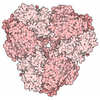[English] 日本語
 Yorodumi
Yorodumi- PDB-5khu: Model of human Anaphase-promoting complex/Cyclosome (APC15 deleti... -
+ Open data
Open data
- Basic information
Basic information
| Entry | Database: PDB / ID: 5khu | ||||||
|---|---|---|---|---|---|---|---|
| Title | Model of human Anaphase-promoting complex/Cyclosome (APC15 deletion mutant), in complex with the Mitotic checkpoint complex (APC/C-CDC20-MCC) based on cryo EM data at 4.8 Angstrom resolution | ||||||
 Components Components |
| ||||||
 Keywords Keywords | CELL CYCLE / inhibition / mitosis / conformational change | ||||||
| Function / homology |  Function and homology information Function and homology informationmitotic spindle assembly checkpoint MAD1-MAD2 complex / metaphase/anaphase transition of cell cycle / metaphase/anaphase transition of meiosis I / Inhibition of the proteolytic activity of APC/C required for the onset of anaphase by mitotic spindle checkpoint components / mitotic checkpoint complex / positive regulation of anaphase-promoting complex-dependent catabolic process / positive regulation of mitotic cell cycle spindle assembly checkpoint / establishment of centrosome localization / positive regulation of synapse maturation / regulation of meiotic nuclear division ...mitotic spindle assembly checkpoint MAD1-MAD2 complex / metaphase/anaphase transition of cell cycle / metaphase/anaphase transition of meiosis I / Inhibition of the proteolytic activity of APC/C required for the onset of anaphase by mitotic spindle checkpoint components / mitotic checkpoint complex / positive regulation of anaphase-promoting complex-dependent catabolic process / positive regulation of mitotic cell cycle spindle assembly checkpoint / establishment of centrosome localization / positive regulation of synapse maturation / regulation of meiotic nuclear division / Conversion from APC/C:Cdc20 to APC/C:Cdh1 in late anaphase / regulation of dendrite development / meiotic sister chromatid cohesion, centromeric / Inactivation of APC/C via direct inhibition of the APC/C complex / APC/C:Cdc20 mediated degradation of mitotic proteins / positive regulation of synaptic plasticity / Phosphorylation of Emi1 / anaphase-promoting complex / Aberrant regulation of mitotic exit in cancer due to RB1 defects / regulation of meiotic cell cycle / anaphase-promoting complex-dependent catabolic process / metaphase/anaphase transition of mitotic cell cycle / protein branched polyubiquitination / Phosphorylation of the APC/C / anaphase-promoting complex binding / regulation of exit from mitosis / nuclear pore nuclear basket / protein localization to chromosome, centromeric region / outer kinetochore / positive regulation of dendrite morphogenesis / positive regulation of mitotic metaphase/anaphase transition / positive regulation of ubiquitin protein ligase activity / ubiquitin ligase activator activity / protein K11-linked ubiquitination / negative regulation of mitotic cell cycle / regulation of mitotic metaphase/anaphase transition / mitotic sister chromatid cohesion / ubiquitin-ubiquitin ligase activity / negative regulation of ubiquitin protein ligase activity / mitotic metaphase chromosome alignment / mitotic spindle assembly checkpoint signaling / Regulation of APC/C activators between G1/S and early anaphase / cullin family protein binding / establishment of mitotic spindle orientation / mitotic sister chromatid segregation / Transcriptional Regulation by VENTX / mitotic spindle assembly / enzyme-substrate adaptor activity / positive regulation of axon extension / ubiquitin-like ligase-substrate adaptor activity / protein K48-linked ubiquitination / heterochromatin / intercellular bridge / Amplification of signal from unattached kinetochores via a MAD2 inhibitory signal / Mitotic Prometaphase / EML4 and NUDC in mitotic spindle formation / APC/C:Cdc20 mediated degradation of Cyclin B / APC-Cdc20 mediated degradation of Nek2A / nuclear periphery / regulation of mitotic cell cycle / Resolution of Sister Chromatid Cohesion / Autodegradation of Cdh1 by Cdh1:APC/C / APC/C:Cdc20 mediated degradation of Securin / SCF-beta-TrCP mediated degradation of Emi1 / Assembly of the pre-replicative complex / Cdc20:Phospho-APC/C mediated degradation of Cyclin A / RHO GTPases Activate Formins / G protein-coupled receptor binding / APC/C:Cdh1 mediated degradation of Cdc20 and other APC/C:Cdh1 targeted proteins in late mitosis/early G1 / brain development / negative regulation of protein catabolic process / kinetochore / CDK-mediated phosphorylation and removal of Cdc6 / spindle / histone deacetylase binding / neuron projection development / spindle pole / ubiquitin-protein transferase activity / mitotic spindle / Separation of Sister Chromatids / ubiquitin protein ligase activity / Antigen processing: Ubiquitination & Proteasome degradation / nervous system development / mitotic cell cycle / microtubule cytoskeleton / Senescence-Associated Secretory Phenotype (SASP) / ubiquitin-dependent protein catabolic process / protein phosphatase binding / molecular adaptor activity / cell differentiation / non-specific serine/threonine protein kinase / protein kinase activity / Ub-specific processing proteases / protein ubiquitination / ciliary basal body / negative regulation of gene expression / cell division / protein serine kinase activity / intracellular membrane-bounded organelle / protein serine/threonine kinase activity Similarity search - Function | ||||||
| Biological species |  Homo sapiens (human) Homo sapiens (human) | ||||||
| Method | ELECTRON MICROSCOPY / single particle reconstruction / cryo EM / Resolution: 4.8 Å | ||||||
 Authors Authors | Yamaguchi, M. / VanderLinden, R. / Dube, P. / Stark, H. / Schulman, B. | ||||||
 Citation Citation |  Journal: Mol Cell / Year: 2016 Journal: Mol Cell / Year: 2016Title: Cryo-EM of Mitotic Checkpoint Complex-Bound APC/C Reveals Reciprocal and Conformational Regulation of Ubiquitin Ligation. Authors: Masaya Yamaguchi / Ryan VanderLinden / Florian Weissmann / Renping Qiao / Prakash Dube / Nicholas G Brown / David Haselbach / Wei Zhang / Sachdev S Sidhu / Jan-Michael Peters / Holger Stark ...Authors: Masaya Yamaguchi / Ryan VanderLinden / Florian Weissmann / Renping Qiao / Prakash Dube / Nicholas G Brown / David Haselbach / Wei Zhang / Sachdev S Sidhu / Jan-Michael Peters / Holger Stark / Brenda A Schulman /     Abstract: The mitotic checkpoint complex (MCC) coordinates proper chromosome biorientation on the spindle with ubiquitination activities of CDC20-activated anaphase-promoting complex/cyclosome (APC/C(CDC20)). ...The mitotic checkpoint complex (MCC) coordinates proper chromosome biorientation on the spindle with ubiquitination activities of CDC20-activated anaphase-promoting complex/cyclosome (APC/C(CDC20)). APC/C(CDC20) and two E2s, UBE2C and UBE2S, catalyze ubiquitination through distinct architectures for linking ubiquitin (UB) to substrates and elongating polyUB chains, respectively. MCC, which contains a second molecule of CDC20, blocks APC/C(CDC20)-UBE2C-dependent ubiquitination of Securin and Cyclins, while differentially determining or inhibiting CDC20 ubiquitination to regulate spindle surveillance, checkpoint activation, and checkpoint termination. Here electron microscopy reveals conformational variation of APC/C(CDC20)-MCC underlying this multifaceted regulation. MCC binds APC/C-bound CDC20 to inhibit substrate access. However, rotation about the CDC20-MCC assembly and conformational variability of APC/C modulate UBE2C-catalyzed ubiquitination of MCC's CDC20 molecule. Access of UBE2C is limiting for subsequent polyubiquitination by UBE2S. We propose that conformational dynamics of APC/C(CDC20)-MCC modulate E2 activation and determine distinctive ubiquitination activities as part of a response mechanism ensuring accurate sister chromatid segregation. | ||||||
| History |
|
- Structure visualization
Structure visualization
| Movie |
 Movie viewer Movie viewer |
|---|---|
| Structure viewer | Molecule:  Molmil Molmil Jmol/JSmol Jmol/JSmol |
- Downloads & links
Downloads & links
- Download
Download
| PDBx/mmCIF format |  5khu.cif.gz 5khu.cif.gz | 390.2 KB | Display |  PDBx/mmCIF format PDBx/mmCIF format |
|---|---|---|---|---|
| PDB format |  pdb5khu.ent.gz pdb5khu.ent.gz | 212.6 KB | Display |  PDB format PDB format |
| PDBx/mmJSON format |  5khu.json.gz 5khu.json.gz | Tree view |  PDBx/mmJSON format PDBx/mmJSON format | |
| Others |  Other downloads Other downloads |
-Validation report
| Summary document |  5khu_validation.pdf.gz 5khu_validation.pdf.gz | 1.1 MB | Display |  wwPDB validaton report wwPDB validaton report |
|---|---|---|---|---|
| Full document |  5khu_full_validation.pdf.gz 5khu_full_validation.pdf.gz | 1.1 MB | Display | |
| Data in XML |  5khu_validation.xml.gz 5khu_validation.xml.gz | 91.6 KB | Display | |
| Data in CIF |  5khu_validation.cif.gz 5khu_validation.cif.gz | 146.8 KB | Display | |
| Arichive directory |  https://data.pdbj.org/pub/pdb/validation_reports/kh/5khu https://data.pdbj.org/pub/pdb/validation_reports/kh/5khu ftp://data.pdbj.org/pub/pdb/validation_reports/kh/5khu ftp://data.pdbj.org/pub/pdb/validation_reports/kh/5khu | HTTPS FTP |
-Related structure data
| Related structure data |  4021MC  4022C  4023C  4024C  4025C  4026C  4027C  4028C  5khrC M: map data used to model this data C: citing same article ( |
|---|---|
| Similar structure data |
- Links
Links
- Assembly
Assembly
| Deposited unit | 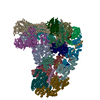
|
|---|---|
| 1 |
|
- Components
Components
-Anaphase-promoting complex subunit ... , 10 types, 12 molecules ABEGWILMNOXY
| #1: Protein | Mass: 217580.172 Da / Num. of mol.: 1 Source method: isolated from a genetically manipulated source Source: (gene. exp.)  Homo sapiens (human) / Gene: ANAPC1, TSG24 / Production host: Homo sapiens (human) / Gene: ANAPC1, TSG24 / Production host:  Trichoplusia ni (cabbage looper) / References: UniProt: Q9H1A4 Trichoplusia ni (cabbage looper) / References: UniProt: Q9H1A4 | ||||||||||||
|---|---|---|---|---|---|---|---|---|---|---|---|---|---|
| #2: Protein | Mass: 9854.647 Da / Num. of mol.: 1 Source method: isolated from a genetically manipulated source Source: (gene. exp.)  Homo sapiens (human) / Gene: ANAPC11, HSPC214 / Production host: Homo sapiens (human) / Gene: ANAPC11, HSPC214 / Production host:  Trichoplusia ni (cabbage looper) / References: UniProt: Q9NYG5 Trichoplusia ni (cabbage looper) / References: UniProt: Q9NYG5 | ||||||||||||
| #4: Protein | Mass: 11677.995 Da / Num. of mol.: 1 Source method: isolated from a genetically manipulated source Source: (gene. exp.)  Homo sapiens (human) / Gene: ANAPC16, C10orf104, CENP-27 / Production host: Homo sapiens (human) / Gene: ANAPC16, C10orf104, CENP-27 / Production host:  Trichoplusia ni (cabbage looper) / References: UniProt: Q96DE5 Trichoplusia ni (cabbage looper) / References: UniProt: Q96DE5 | ||||||||||||
| #6: Protein | Mass: 9920.108 Da / Num. of mol.: 2 Source method: isolated from a genetically manipulated source Source: (gene. exp.)  Homo sapiens (human) / Gene: CDC26, ANAPC12, C9orf17 / Production host: Homo sapiens (human) / Gene: CDC26, ANAPC12, C9orf17 / Production host:  Trichoplusia ni (cabbage looper) / References: UniProt: Q8NHZ8 Trichoplusia ni (cabbage looper) / References: UniProt: Q8NHZ8#7: Protein | | Mass: 92303.305 Da / Num. of mol.: 1 Source method: isolated from a genetically manipulated source Source: (gene. exp.)  Homo sapiens (human) / Gene: ANAPC4, APC4 / Production host: Homo sapiens (human) / Gene: ANAPC4, APC4 / Production host:  Trichoplusia ni (cabbage looper) / References: UniProt: Q9UJX5 Trichoplusia ni (cabbage looper) / References: UniProt: Q9UJX5#9: Protein | | Mass: 21310.152 Da / Num. of mol.: 1 Source method: isolated from a genetically manipulated source Source: (gene. exp.)  Homo sapiens (human) / Gene: ANAPC10, APC10 / Production host: Homo sapiens (human) / Gene: ANAPC10, APC10 / Production host:  Trichoplusia ni (cabbage looper) / References: UniProt: Q9UM13 Trichoplusia ni (cabbage looper) / References: UniProt: Q9UM13#10: Protein | | Mass: 8528.309 Da / Num. of mol.: 1 Source method: isolated from a genetically manipulated source Source: (gene. exp.)  Homo sapiens (human) / Gene: ANAPC13 / Production host: Homo sapiens (human) / Gene: ANAPC13 / Production host:  Trichoplusia ni (cabbage looper) / References: UniProt: Q9BS18 Trichoplusia ni (cabbage looper) / References: UniProt: Q9BS18#11: Protein | | Mass: 94149.156 Da / Num. of mol.: 1 Source method: isolated from a genetically manipulated source Source: (gene. exp.)  Homo sapiens (human) / Gene: ANAPC2, APC2, KIAA1406 / Production host: Homo sapiens (human) / Gene: ANAPC2, APC2, KIAA1406 / Production host:  Trichoplusia ni (cabbage looper) / References: UniProt: Q9UJX6 Trichoplusia ni (cabbage looper) / References: UniProt: Q9UJX6#12: Protein | | Mass: 85445.961 Da / Num. of mol.: 1 Source method: isolated from a genetically manipulated source Source: (gene. exp.)  Homo sapiens (human) / Gene: ANAPC5, APC5 / Production host: Homo sapiens (human) / Gene: ANAPC5, APC5 / Production host:  Trichoplusia ni (cabbage looper) / References: UniProt: Q9UJX4 Trichoplusia ni (cabbage looper) / References: UniProt: Q9UJX4#17: Protein | Mass: 63386.152 Da / Num. of mol.: 2 Source method: isolated from a genetically manipulated source Source: (gene. exp.)  Homo sapiens (human) / Gene: ANAPC7, APC7 / Production host: Homo sapiens (human) / Gene: ANAPC7, APC7 / Production host:  Trichoplusia ni (cabbage looper) / References: UniProt: Q9UJX3 Trichoplusia ni (cabbage looper) / References: UniProt: Q9UJX3 |
-Cell division cycle protein ... , 4 types, 8 molecules CPFHJKRS
| #3: Protein | Mass: 69075.133 Da / Num. of mol.: 2 Source method: isolated from a genetically manipulated source Source: (gene. exp.)  Homo sapiens (human) / Gene: CDC23, ANAPC8 / Production host: Homo sapiens (human) / Gene: CDC23, ANAPC8 / Production host:  Trichoplusia ni (cabbage looper) / References: UniProt: Q9UJX2 Trichoplusia ni (cabbage looper) / References: UniProt: Q9UJX2#5: Protein | Mass: 92519.547 Da / Num. of mol.: 2 Source method: isolated from a genetically manipulated source Source: (gene. exp.)  Homo sapiens (human) / Gene: CDC27, ANAPC3, D0S1430E, D17S978E / Production host: Homo sapiens (human) / Gene: CDC27, ANAPC3, D0S1430E, D17S978E / Production host:  Trichoplusia ni (cabbage looper) / References: UniProt: P30260 Trichoplusia ni (cabbage looper) / References: UniProt: P30260#8: Protein | Mass: 71929.656 Da / Num. of mol.: 2 Source method: isolated from a genetically manipulated source Source: (gene. exp.)  Homo sapiens (human) / Gene: CDC16, ANAPC6 / Production host: Homo sapiens (human) / Gene: CDC16, ANAPC6 / Production host:  Trichoplusia ni (cabbage looper) / References: UniProt: Q13042 Trichoplusia ni (cabbage looper) / References: UniProt: Q13042#14: Protein | Mass: 54796.508 Da / Num. of mol.: 2 Source method: isolated from a genetically manipulated source Source: (gene. exp.)  Homo sapiens (human) / Gene: CDC20 / Production host: Homo sapiens (human) / Gene: CDC20 / Production host:  Trichoplusia ni (cabbage looper) / References: UniProt: Q12834 Trichoplusia ni (cabbage looper) / References: UniProt: Q12834 |
|---|
-Protein , 2 types, 2 molecules QT
| #13: Protein | Mass: 120004.242 Da / Num. of mol.: 1 Source method: isolated from a genetically manipulated source Source: (gene. exp.)  Homo sapiens (human) / Gene: BUB1B, BUBR1, MAD3L, SSK1 / Production host: Homo sapiens (human) / Gene: BUB1B, BUBR1, MAD3L, SSK1 / Production host:  Trichoplusia ni (cabbage looper) Trichoplusia ni (cabbage looper)References: UniProt: O60566, non-specific serine/threonine protein kinase |
|---|---|
| #15: Protein | Mass: 23533.883 Da / Num. of mol.: 1 Source method: isolated from a genetically manipulated source Source: (gene. exp.)  Homo sapiens (human) / Gene: MAD2L1, MAD2 / Production host: Homo sapiens (human) / Gene: MAD2L1, MAD2 / Production host:  Trichoplusia ni (cabbage looper) / References: UniProt: Q13257 Trichoplusia ni (cabbage looper) / References: UniProt: Q13257 |
-Protein/peptide , 1 types, 1 molecules U
| #16: Protein/peptide | Mass: 785.911 Da / Num. of mol.: 1 Source method: isolated from a genetically manipulated source Source: (gene. exp.)  Homo sapiens (human) / Production host: Homo sapiens (human) / Production host:  Trichoplusia ni (cabbage looper) Trichoplusia ni (cabbage looper) |
|---|
-Experimental details
-Experiment
| Experiment | Method: ELECTRON MICROSCOPY |
|---|---|
| EM experiment | Aggregation state: PARTICLE / 3D reconstruction method: single particle reconstruction |
- Sample preparation
Sample preparation
| Component | Name: Model of human Anaphase-promoting complex/Cyclosome (APC15 deletion mutant), in complex with the Mitotic checkpoint complex (APC/C-CDC20-MCC) based on cryo EM data at 4.8 Angstrom resolution Type: COMPLEX / Entity ID: all / Source: MULTIPLE SOURCES |
|---|---|
| Molecular weight | Value: 1.4 MDa / Experimental value: NO |
| Buffer solution | pH: 8 |
| Specimen | Embedding applied: NO / Shadowing applied: NO / Staining applied: NO / Vitrification applied: YES |
| Vitrification | Cryogen name: ETHANE |
- Electron microscopy imaging
Electron microscopy imaging
| Experimental equipment |  Model: Titan Krios / Image courtesy: FEI Company |
|---|---|
| Microscopy | Model: FEI TITAN KRIOS |
| Electron gun | Electron source:  FIELD EMISSION GUN / Accelerating voltage: 300 kV / Illumination mode: SPOT SCAN FIELD EMISSION GUN / Accelerating voltage: 300 kV / Illumination mode: SPOT SCAN |
| Electron lens | Mode: BRIGHT FIELD |
| Image recording | Electron dose: 40 e/Å2 / Film or detector model: FEI FALCON II (4k x 4k) |
- Processing
Processing
| CTF correction | Type: PHASE FLIPPING AND AMPLITUDE CORRECTION |
|---|---|
| 3D reconstruction | Resolution: 4.8 Å / Resolution method: FSC 0.143 CUT-OFF / Num. of particles: 268851 / Symmetry type: POINT |
 Movie
Movie Controller
Controller



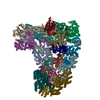
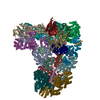

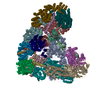
 PDBj
PDBj


